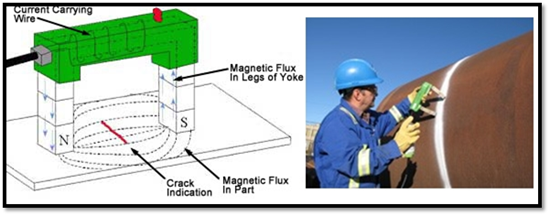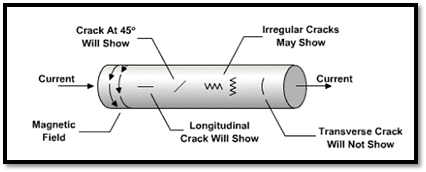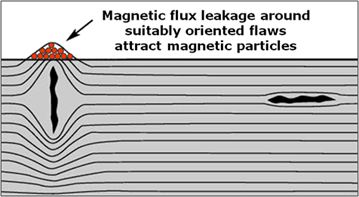Magnetic Particle Examination: Not the Only Way to Test for Flaws
Magnetic Particle Examination (MT) is a popular, relatively low-cost method to perform nondestructive examination on ferromagnetic materials.
#materials
MT is today a standard technique used in the oil and gas industry, especially for valves and piping components. The reason it has become so popular and reliable is summarized in one word: versatility. Pressure-containing parts are always considered the most critical elements of a valve assembly, not only because the industry is leading to more extreme challenges in terms of applications and service, but also due to the large amount of steel that is produced in countries where the culture of “total quality” and “zero defect” is less imperative.
Valve bodies may have complex geometries or very large surfaces, but these do not limit the applicability of MT. Surface preparation is not as critical as other NDE techniques, and in a world of quick turnaround times and short deliveries, every process that appears lean and simple is considered advantageous.
A large valve body can be inspected quickly; either a direct magnetization current is flowing through the component when clamped between large electrodes, or indirect magnetization is accomplished by using a strong external magnetic field to establish magnetic flux within the component. This magnetic flux naturally flows in the part in one of the established directions, but when a discontinuity, flaw or defect is encountered, a deviation (or leak) of the flux will occur. The metallic powder applied on the component under testing will form a visual indication of defect present on the surface or just underneath.
MT is also a viable and well-established method to inspect welds on assembled components, especially pressure-containing welds on valves bodies. A portable instrument (Figure 1) with two electrodes is used to force the magnetic field to the appropriate direction; this technique is largely used in the field to run periodic inspection of piping and all welded valves.
It is important to note that, to obtain good results by inspecting parts with MT, multiple directions of magnetic field must be used. Cracks that are parallel to the magnetic field may not show (Figure 2).
Are There Alternatives to Magnetic Particle Inspection?
Unfortunately, exploiting the properties of metallic materials to inspect them is not a flawless discovery. The fundamental condition is that it only works with magnetic materials, and only a portion of the metals that are used in the valve industry are magnetic. We described the principle of ferromagnetic materials (or those who behave like iron), but when dealing with allotropes, things change dramatically. Austenitic stainless-steel materials often are the only materials suitable for specific applications where low temperature or corrosion resistance prevent the use of carbon steel. It is not possible to establish a magnetic flux in non-magnetic materials, and the need to achieve high-quality levels is still imperative.
As an alternative to MT, surface examination can be done by means of Liquid Penetrant testing (PT). This method is based on the capillarity principle and doesn’t rely on magnetic properties.
A component is carefully cleaned and a low surface-tension liquid with high wetting characteristics is applied to the surface and given time to seep into surface-breaking defects. After removing the excess of penetrant liquid, a developer agent (usually white powder) is applied to pull the trapped penetrant out of the defect and spread it on the surface where it can be seen.
This method is widely used for valve trim components (most likely to be made with non-ferromagnetic materials), and it provides direct readings and indication of defects. However, it can detect only cracks that open on the surface, both an advantage and a limit of the technique. Large and complicated geometries can be easily inspected with this relatively inexpensive technique, but the limitation of surface crack detections and the massive use of chemicals drove the industry to find other alternatives to magnetic particle testing for non-ferromagnetic materials.
Eddy current inspection (ECT) is another viable option. It does not require many of the consumables used for PT or MT with their attendant expensive disposal, so it is more environmentally friendly. Eddy currents are induced electrical currents that flow in a circular path. They get their name from “eddies” that are formed when a liquid or gas flows in a circular path around obstacles when conditions are right. Besides the fact that this method still uses magnetic principles, if the component under test is capable of conducting electricity (and the vast majority of metals are good or decent conductors), then the method is applicable.
Conclusion
While magnetic particle examination is a valuable method of testing for flaws, the complexities of material composition necessitate a variety of non-destructive methods, each with their unique capabilities. As materials continue to evolve, new testing methods will no doubt be created to adapt.
Alberto Daglio is senior engineer of Valves & Measurement at Cameron, a Schlumberger company. An expanded version of this article, with background information on the physics of magnetism, is available on LinkedIn.
RELATED CONTENT
-
Control Valves for Hydrogen Applications
Proper sizing, material selection and monitoring are as important as ever.
-
The Materials That Make Up Valves
EDITOR’S NOTE: Materials used in the manufacture of valves and how they perform in different applications is a topic of huge interest to everyone who works with valves.
-
Metal Additive Manufacturing: the Evolving Road to Adoption and Standardization
Greater knowledge and acceptance of metal AM valve components—especially with various standardization efforts underway—will spur the technology’s growth.










 Unloading large gate valve.jpg;maxWidth=214)


